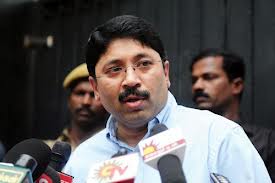
New Delhi, July 27: The Central Bureau of Investigation is poised to file a charge-sheet against DMK leader and former telecom minister Dayanidhi Maran and his brother Kalanithi for allegedly receiving Rs 549 crore for their role in the acquisition of Aircel by Malaysia-based firm Maxis.
CBI sources on Thursday said the agency had questioned Dayanidhi recently, adding that other high-profile connections were also under investigation.
CBI has almost concluded investigations in the Aircel-Maxis case and has claimed illegal gratification was accepted by Dayanidhi through Kalanithi in the garb of premium share investment in family-controlled Sun Direct. The agency also claimed that as telecom minister, he blocked the legitimate requests of Dishnet DSL, paving the way for the Maxis takeover.
In a status report to the Joint Parliamentary Committee on telecom on Tuesday, CBI said mala fide considerations and an "illegal gratification" of Rs 549 crore were behind the "active intervention" of Dayanidhi and Kalanithi in curbing the business interests of Aircel's former owner C Sivasankaran.
When contacted, Dayanidhi told TOI that he did not want to offer any comment on the CBI report to JPC. He said he would not comment on a report said to have been presented to a parliamentary committee. "Only when a report is presented to Parliament can I comment on it," he said.
Alleging a Maran-Maxis nexus, CBI said, "It is prima facie revealed that the active intervention of Dayanidhi Maran and his brother Kalanithi Maran in restricting business environment of Siva Group, change of ownership to M/s Maxis Communications and undue favours post this change was for mala fide considerations."
In its report, CBI said "undue favours" were offered to Maxis even after it took over Aircel and these were part of a plan involving Dayanidhi when he was telecom minister in UPA-1.
"An illegal gratification of Rs 549,96,01,793 was accepted as quid pro quo through his brother Kalanithi Maran in the garb of share premium invested in Sun Direct by M/s South Asia Entertainment Holdings which was a fully owned subsidiary of M/s Astro All Asia Networks," the CBI said.
The agency said Dayanidhi delayed grant of licences in seven telecom circles to Aircel and other approvals pending before DoT on "frivolous grounds" with the intention of forcing its exit from the telecom business.
Backing Sivasankaran's allegations that he was arm-twisted into selling Aircel to Maxis, CBI said Dayanidhi "rendered disservice to Dishnet (Aircel) paving the way for Maxis to acquire Aircel from Sivasankaran".
CBI said one Ralph Marshall of Maxis, on behalf of the firm's owner Ananda Krishnan, was in touch with Dayanidhi and Kalanithi prior to Aircel changing hands.
Pointing to how the attitude of DoT changed once Maxis took over Aircel, CBI said application for issuance of licences and other requests pending for long were acceded to and "undue favour was given to these companies for which alleged illegal gratification was paid by M/s Astro All Asia Networks to M/s Sun Direct of Kalanithi in the garb of purchase of its shares at a premium of Rs 69.57 a share".
The CBI probe showed directions were issued that show-cause notices be linked with issuance of licences, halting grant of licences to Dishnet. "Delays in allocation of licences to Dishnet and allocation of spectrum to it for various circles resulted in loss of revenue to Department of Telecom (DoT) which could have accrued by way of entry fee, licence fee and spectrum charges," agency sources said.





Comments
Add new comment